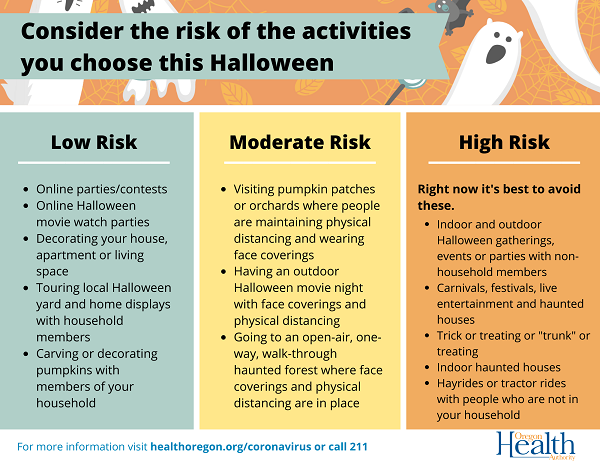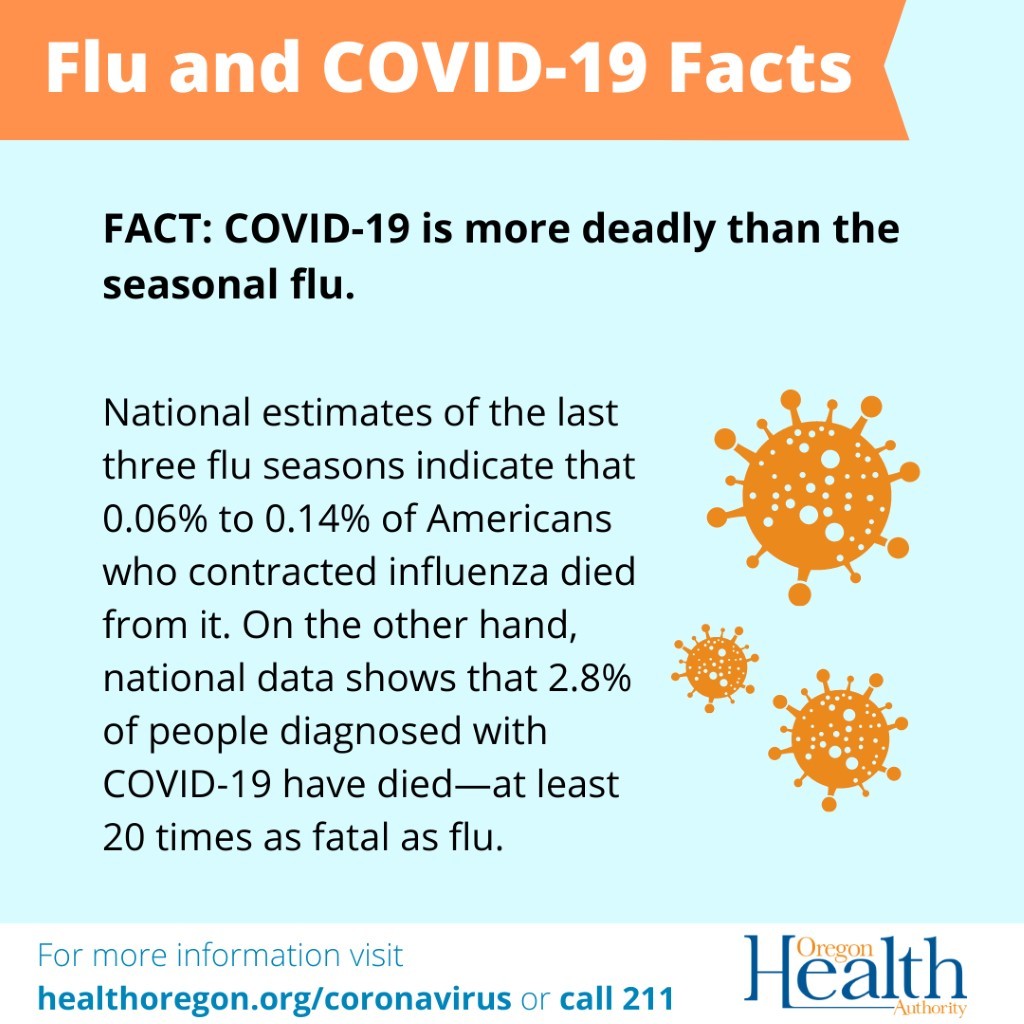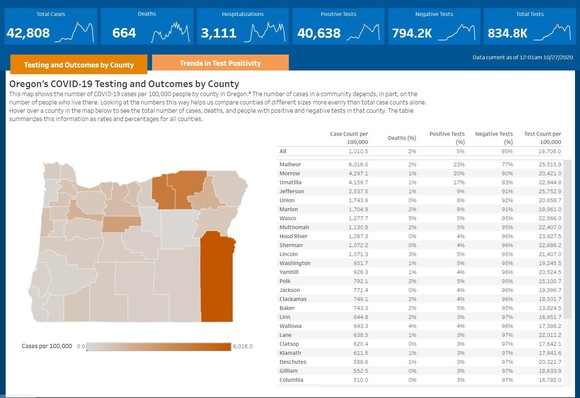|
Dear Friends and Neighbors,
Holidays are pointed reminders of what life was like before the pandemic.
For many, Halloween is full of special memories. It’s also an exciting time for children, especially this year as they have had to deal with the challenges of distance learning and separation from friends.
This Halloween comes at a critical juncture in the pandemic, as COVID-19 cases have risen recently. Today marks the eighth day in a row for Oregon recording 300+ new cases each day, including a record-high 550 cases last Friday. The latest weekly data indicates a 6.5% weekly test positivity rate, marking the seventh week in a row we’ve recorded a rate of 5% or above and the first rate above 6% in nearly two months.
For Halloween activities, the Centers for Disease Control and Prevention (CDC) and the Oregon Health Authority (OHA) recommend that Oregonians avoid traditional door-to-door trick or treating and “Trunk or Treat” events because these are high risk activities for crowding among people who are outside your household.
Some ideas for safer, low-risk activities include: holding an online costume contest, watching a scary movie online, carving pumpkins with people in your household, decorating your house or apartment, or touring the neighborhood to look at decorated houses with members of your household.
Here is what the CDC recommends for this coming Halloween:
- Avoid direct contact with trick-or-treaters.
- Give out treats outdoors, instead of indoors.
- Set up a station with individually bagged treats for kids to take.
- Wash hands before handling treats.
- Wear a mask.
The CDC has suggested some of the following alternatives:
- Hide Halloween treats in and around your house.
- Hold a Halloween treat hunt with household members.
- Hold an outdoor costume parade or contest so everyone can show off their costumes.
- Host an outdoor Halloween movie night with friends or neighbors or an indoor movie night with your household members.
If you’re in an area where people might still come to your door despite the public health recommendations, it’s important to maintain distance and wear a mask. Some folks in other parts of the country have gotten creative. For example, an Ohio man recently built a candy chute by attaching a long cardboard tube to a railing of his front steps to slide candy down so that trick-or-treaters who did come by could still receive treats while maintaining physical distance and he could avoid direct contact with people outside his household.
This doesn’t have to be a stark choice between doing what you did last year or not doing anything because of the pandemic. Just please keep these risk factors in mind this week and have safe fun.

We know that wearing masks or other face coverings will reduce the spread of COVID-19, but it can be impactful to see this in new ways with clear data. Hat tip to Senator Michael Dembrow, who included this graphic from Carnegie Mellon University in one of his newsletters last week. It comes from an article which ran here in the Washington Post. The article notes that data analyzed by the university shows that as mask use increases, the frequency of observed COVID-19 symptoms decreases.

The chart notes that 86% of Oregonians sampled for this study say they wear masks when in public. This is a similar finding to the recent Oregon Health Authority Statewide COVID-19 Survey, which said that 84% of Oregonians wear a face mask indoors in public nearly all the time.
It’s heartening to see most Oregonians have a commitment to wearing a mask in public. As the CDC has said, mask usage might be as impactful in stopping the spread of infection as a vaccine.
I’m including another reminder that the CDC encourages everyone 6-months-old or older to get their flu shot by the end of the month. Doing so will help improve our hospital capacity during flu season. As The Oregonian notes here, public health officials have warned our hospitals could reach capacity by middle or late December if our COVID-19 infection rates don’t decrease.
The flu vaccine does not make people susceptible to COVID-19, and there is no evidence that getting a flu vaccination increases your risk of getting sick from a coronavirus, like the one that causes COVID-19. As the graphic from OHA notes below, COVID-19 is far more deadly than the seasonal flu.
For more information on flu season, you can watch the OHA’s expert Q&A session on the issue here.

Disaster survivors affected by wildfires might get a letter from the Federal Emergency Management Agency (FEMA) telling them they are ineligible for assistance. However, if an applicant believes FEMA’s decision is wrong, there is a way to file an appeal.
Here is more information on how to file an appeal from the Oregon Office of Emergency Management:
The first step is for applicants to read their determination letter carefully to understand why FEMA decided the application was “ineligible.” Many times, it could be something as simple as providing missing documents or information.
Important Documents to Include with an Appeal Letter
Often, applicants need only to submit extra documents for FEMA to process their application. FEMA may find an applicant ineligible if the following documents are missing:
- Insurance documents: Provide documents from your insurance company that show your policy coverage and/or settlement is not enough to make essential home repairs, provide a place to stay, or replace certain contents. FEMA cannot duplicate homeowner or renter insurance benefits.
- Proof of occupancy: Provide documents that prove the damaged home or rental was your primary residence by supplying a copy of utility bills, driver’s license or lease.
- Proof of ownership. Provide mortgage or insurance documents, tax receipts or a deed. If you don’t have a deed handy, contact your local or county officials about obtaining a copy.
- Lost documents? Visit the following website for information on replacing lost documents: https://www.usa.gov/replace-vital-documents
All appeals must be in writing. The appeal letter should explain why the applicant thinks FEMA’s decision is not correct. When filing an appeal, it is important to include any documentation FEMA requests and/or that supports the appeal claim. Also, if the person writing the appeal letter is not the applicant or a member of the household, applicants must submit a signed statement that the writer is authorized to act on the behalf of the applicant.
How to Submit an Appeal
IMPORTANT: Be sure to include the cover letter you received from FEMA when you submit your appeal documents.
- Mail documents and your appeal letter within 60 days of receiving your determination letter to: FEMA National Processing Service Center, P.O. Box 10055 Hyattsville, MD 20782-8055
- Fax them to 800-827-8112.
- To set up a FEMA online account or to upload documents online, visit disasterassistance.gov and click on “Check Your Application and Log In” and follow the directions.
- Governor Brown announced that she is extending the COVID-19 state of emergency declaration for another 60 days, through January 2, 2021. The last declaration was set to expire next week. Oregon Public Broadcasting has more here.
- Household financial distress will grow as the pandemic continues, especially if there is not another federal stimulus package this fall. KGW reports here about growing concerns about auto repossessions.
- Josephine County (Grants Pass and Cave Junction) will have several free COVID-19 testing events this week, as KDRV reports here.
- The Oregon Health Authority reported 391 new confirmed cases of coronavirus, bringing the statewide total of new and presumptive cases to 42,808. The OHA also reported nine more deaths, meaning 664 Oregonians have died of the coronavirus. You can click the images below for links to interactive data tables about coronavirus in Oregon.



To read past newsletters, you can go to this link. For up to date information, please check this link to the Oregon Health Authority where regular updates are posted: https://www.oregon.gov/oha/ERD/Pages/News-Releases.aspx
Please email me at Rep.TinaKotek@oregonlegislature.gov if you have specific concerns that have not been addressed by the OHA. Our office will do all we can to help and protect all Oregonians.
Thank you for reading! We will get through this together.
Best,

Tina Kotek
State Representative
House District 44
Speaker of the House
email: Rep.TinaKotek@oregonlegislature.gov I phone: 503-986-1200
address: 900 Court St NE, H-269, Salem, OR 97301
website: http://www.oregonlegislature.gov/kotek
|